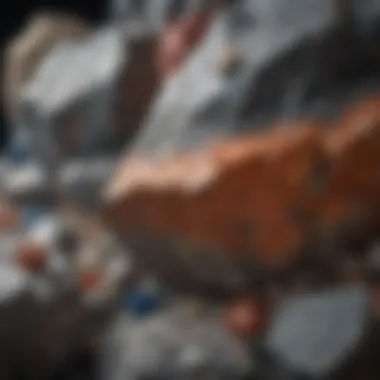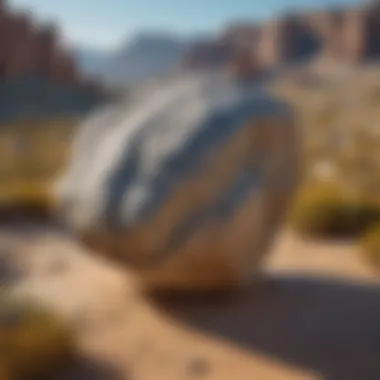Exploring the Enduring Properties of Granite for Collectors


Intro
Granite is a fascinating and durable igneous rock composed primarily of quartz, feldspar, and mica. It is widely sought after, not only for its aesthetic value but also for its practical applications in various fields. For collectors and enthusiasts, understanding the properties of granite goes beyond mere appreciation. It involves recognizing its geological history, characteristics, and multitude of uses. This article offers a comprehensive guide to exploring granite's properties, enabling collectors to deepen their knowledge and expand their collections.
Rock and Fossil Identification
Identification of granite, as a rock, requires a keen eye and awareness of specific features. Each piece of granite can tell a unique story about its formation and the conditions during that time. Here are key points to consider:
Types of Granite
Granite can be classified into various types based on mineral composition and texture:
- Biotite granite: Contains biotite mica and has a coarse texture.
- Syenite granite: Has a higher ratio of feldspar and lacks quartz.
- Quartz-rich granite: High concentration of quartz, providing a sparkling appearance.
Characteristics to Look For
When identifying granite, observe the following traits:
- Color variations, often ranging from light to dark shades.
- Crystal patterns, showcasing the arrangement of minerals.
- Hardness, measuring 6 to 7 on the Mohs scale, which includes testing with metal and scratching tools.
Tools for Identification
Effective identification can be achieved with the right set of tools:
- Hand lens: Helpful for examining crystal structures.
- Field guides: To compare various granite species.
- Geological hammer: For natural examination and testing hardiness of specimens.
Collecting Tips and Techniques
For those aiming to collect granite specimens, methods and strategies are important. This ensures a productive and enjoyable experience.
Best Practices for Collecting
To enhance your experience:
- Respect local laws.
- Always be mindful of the ecosystem while collecting.
- Only collect materials from designated sites.
Locating Prime Collecting Sites
You can find impressive granite pieces through:
- Visiting quarries and exposed rock faces.
- Researching geological maps for notable formations.
- Attending local rock and mineral shows, where enthusiasts gather.
How to Safely Extract Specimens
To extract specimens securely:
- Use proper tools designed for rock collection.
- Wear appropriate protective gear to prevent injuries.
- Follow extraction guidelines to maintain the structural integrity of both the specimen and the surrounding environment.
Preservation and Display
Once you have collected granite specimens, storing and showcasing them becomes vital to preserving their quality.
Techniques for Preserving Rocks
To maintain the best condition of your granite:
- Use repair kits for chips or cracks if necessary.
- Keep specimens clean and free from moisture to prevent discoloration.
Proper Storage Methods
Consider these storage tips:
- Store heavy pieces in reinforced boxes
- Utilize padded cases to avoid any shocks.


Creative Display Ideas
To showcase your collection:
- Consider wall-mounted shelves for visual appeal.
- Use well-lit areas to enhance their natural beauty.
Geological Insights
Delving into Granada leads us to valuable geological insights.
Geological Formations and Processes
Understanding how granite forms is pivitol. It typically originates from magma cooling slowly beneath the Earth's surface. This slow cooling allows large crystals to develop, contributing to its unique texture.
Historical Significance of Rocks and Fossils
This rock has been foundational to many regions. Notably used in ancient architecture, granite stands as witness to numerous civilizations.
Notable Discoveries in the Field
Recent discoveries continue to evolve our understanding of granite. Geological surveys worldwide examine granite's implications in shifts and land formations. As new techniques emerge, so does fresh intel about granite's diverse roles in our planet's landscape.
Granite is not just a material; it’s a testament to Earth’s history and geological processes.
Prolusion to Granite
Granite features prominently in various scientific and artistic discussions due to its durability, beauty, and vast applications. For both rock enthusiasts and geological collectors, understanding granite is crucial when delving into its many facets. This introduction sets the stage for a comprehensive examination of granite’s properties and significance, both in a geological context and in the realm of collecting.
Moreover, a grasp of the basic concepts surrounding granite allows collectors to make informed decisions, whether choosing specimens or appreciating their formation and history.
Definition and Formation
Granite is a common type of intrusive igneous rock, characterized by its granular texture and consistsual prominent feldspar, quartz, and mica. The formation of granite occurs deep within the Earth's crust, where magma from partial melting slowly cools and crystallizes over millions of years. This slow cooling process results in the well-defined grains commonly observed in granite.
At its core, granite reflects the intense geological activity of Earth, indicating significant tectonic movements and the history of a region. Its durability derives from this complex formation, making granite resistant to erosion. The predictable composition and structure of granite work to its advantage not only among collectors but also in various practical applocations.
Historical Significance
Throughout human history, granite has played a vital role in construction, sculpture, and art. Ancient civilizations admired granite for its beauty and lasting qualities, often utilizing it for monumental structures. The Pyramids of Giza in Egypt, for instance, feature granite blocks that have stood the test of time.
Moreover, many sculptures, like those crafted by Augusto Rodin, are made from granite, revealing their functional beauty in art. The endurance of these granite structures symbolizes human achievement and shared history. For collectors, granite offers a tangible link to the past, connecting individuals with geological processes and historical practices. As a collectible specimen, granite serves not only an aesthetic purpose but also embodies the temporal narratives of natural and human influence.
Mineral Composition of Granite
Granite is primarily identified by its unique mineral composition. Knowing the specific minerals that constitute granite is essential for collectors and geologists alike. Different minerals not only define the rock's appearance but also its durability and performance in various applications. Understanding the composition provides insight into how granite can be effectively used in construction and sculpture while also informing collectors about the value of specific types of granite.
Common Minerals in Granite
Granite typically consists of four main minerals. These are feldspar, quartz, mica, and trace minerals. Each plays a crucial role in determining the granite's characteristics. Collectors benefit from learning about these common minerals and how they contribute to the overall profile of granite.
Feldspar
Feldspar is the most abundant mineral found in granite. It can constitute a significant portion of the rock, often accounting for about 60% of its composition. The presence of feldspar is critical because it imparts strength and structure to the granite.
One of the key characteristics of feldspar is its ability to crystallize in various forms, which can lead to significant variations in granite color. The unique feature of feldspar lies in its hardness, rating about 6 to 6.5 on the Mohs scale. This makes granites containing feldspar particularly durable and suitable for construction and ornamental use. However, feldspar can be susceptible to weathering, which might affect its appearance over time.
Quartz
Quartz is another predominant mineral in granite, contributing significantly to its overall hardness. It can make up to 20-35% of granite's composition. The main aspect of quartz is its resilience against weathering and its reddish or white variations, which enhance the aesthetic value of the stone.
One notable feature of quartz is its vitreous luster, providing a shiny and attractive finish when polished. This characteristic is beneficial for applications like countertops and decorative elements. The main disadvantage is that excessive quartz can lead to brittleness in the granite, making it more prone to cracking under stress.
Mica
Mica, typically found in smaller quantities—around 5-10%—is another important mineral in granite. Its key characteristic is the ability to form layers or flakes, resulting in a shimmer that can increase the visual appeal of the rock. Mica's contribution is primarily aesthetic and tactile; its unique feature is that it enhances the overall beauty of granite.
However, even though mica can add to the desirability of granite, excessive amounts may reduce its strength or make the stone less favorable for use in structures that need higher durability.
Other Trace Minerals
Other trace minerals can include amphibole, biotite, and garnet. While they only account for a small fraction of the overall composition, these minerals add to the uniqueness of specific granite types. Their presence affects both color and texture, making some granites more desirable to collectors.


These trace minerals often lend excellent characteristics, enhancing the overall value of the granite. However, the variability means that encountering varieties rich in trace minerals might also present challenges in sourcing consistent quality.
Variations in Composition
The composition of granite varies based on location and the specific geological conditions under which it formed. Factors such as temperature, pressure, and the minerals present in the surrounding environment all contribute to these variations. Understanding these complexities can provide deeper insights for collectors and those interested in geology. Features can change quite noticeably within short distances; this phenomenon can lead to a versatile array of granite types found on the market.
Being aware of these variations helps collectors identify specific types of granite and evaluate their properties accordingly.
Physical Properties of Granite
Understanding the physical properties of granite is crucial, not just for geologists but also for rock and fossil collectors. The way granite behaves and appears is influenced by its intrinsic qualities, which can affect decisions regarding collection and usage. These properties contribute to granite's popularity as a building material and a decorative stone and provide insights into its geological history. Looking into the specifics, the durability, color, density, and weight allow both enthusiasts and professionals to distinguish between types and assess their value and usability.
Durability and Weather Resistance
Granite is celebrated for its impressive durability. It is one of the hardest natural stones, composed mainly of quartz and feldspar. This combination gives granite a Mohs hardness of approximately 6 to 7, making it resilient against scratches and abrasion. Its weather resistance further enhances its desirability. Granite can withstand exposure to various environmental conditions without significant degradation.
-> This durability ensures that granite surfaces remain intact even after many years.
In construction, granite is often chosen for countertops and flooring for this very reason and even, it is used for outdoor structures. The stone does not easily absorb water, reducing issues related to freezing and thawing in colder climates. Furthermore, its resistance to many chemicals means it can be cleaned and maintained with minimal effort. Collectors looking for specimens will, therefore, favor types of granite that boast these qualities since they will remain in better conditions over time.
Color and Texture
The aesthetic aspect of granite is equally essential. Granite exhibits a vast range of colors including pink, white, gray, and even black, often marked by flecks or swirls of other minerals. This variety is largely due to the mineral composition and the specific processes of its formation. Collectors take interest in these characteristics, as different types, like the blue Bahama granite or the vibrant Corian amenity, have specific uses in interior design and architecture.
Textures vary from fine to coarse grain, depending on the state in which the mineral crystals cooled and solidified. Collectible granite pieces with unique veining patterns or hues can command higher market prices due to their rarity and beauty. Understanding color and texture not only enhances the collection experience but also aids collectors in contextualizing the origins of their finds.
Density and Weight
Granite is a dense material. Its density typically ranges from 2.63 to 2.75 grams per cubic centimeter, which speaks to its strength. The weight of granite can be a significant factor for collectors and users alike. For instance, larger pieces may require special handling or specific mounting systems in applications, particularly in sculpture or installation art. Clothing regarding the weight will assure proper transport and installation, avoiding any mishaps during movement.
Weight does influence personal collection choices. Some collectors might seek lightweigt pieces for ease, while others may desire heavier specimens for their stability when set up in a display. Therefore, awareness of these measurements is pivotal for any granite enthusiast, allowing for informed collecting and utilizing strategies.
Geological Significance of Granite
Granite holds a significant place in geological studies. As a prevalent igneous rock, it reflects the processes that shaped the Earth’s crust. Its formation comes from the slow crystallization of magma beneath the surface. This uniqueness provides valuable insights into geological events such as continental drift and orogeny, or mountain-building processes. For collectors and enthusiasts, understanding granite's geological importance is not just about the aesthetic value, but also about what the rock represents in Earth’s history.
Granite as an Indicator Rock
Granite can serve as an indicator rock due to the elements that it carries. Its presence can hint at specific geological environments and conditions that triggered its formation. This makes it a key focus in the field of geology, particularly in evaluating orographic uplift processes. In regions where granite is abundant, one can find an oliginal record of past cooling and solidification of magmatic intrusions.
Unlike other rocks, granites have a distinctive textural and mineralogical composition. Feldspar, quartz, and mica not only signify its igneous nature but also point to the cooling rates experienced by the parent magma. The composition levels played within these types can suggest temperature and pressure conditions during their formation.
Additionally, granite locations often correlate to the presence of other significant geological features.cite: en.wikipedia.org
Role in Tectonic Processes
The formation of granite is closely tied to tectonic processes. It primarily forms in conjunction with continental collision. When two tectonic plates converge, immense pressure and heat can cause crustal melting, leading to the creation of granite over millions of years. Understanding how and where granite forms is crucial for geologists studying tectonic movements and volcanic cycles.
This interaction between tectonic plates not only contributes to granite creation but also influences the surface landscape. Newly formed granitic mountains can emerge after uplift as old granite intrusions get exposed through erosion. This ongoing relationship between tectonics and granite allows for a deeper comprehension of the dynamic processes reshaping Earth's surface.
In summary, granite should not only be viewed as a building material or ornamental stone. Its existence signifies dynamic geological processes at work, providing insights into the history and structure of our planet. Collectors looking for granite must consider its geological context and history, enriching their understanding beyond its physical attributes.
Applications of Granite
Granite is not just a visually appealing rock; it serves many significant purposes in both modern tesign and daily life. This section focuses on the various applications of granite that make it valuable. The distinct properties of granite, such as its durability, aesthetics, and ability to withstand weathering, enhance its desirability across several domains. Recognizing the importance of granite allows collectors to understand its broader implications and enhances the appreciation of their collections. There are specific elements that underline granite's relevance: strength, longevity, versatility, and aesthetic appeal.
Construction Uses
Granite is a significant material in the construction industry, appreciated primarily for its robustness. Most commonly, it is used in countertops, flooring tiles, and wall cladding. Its strong surface resists scratches, making it suitable for areas with heavy foot traffic or high use. Architects and designers favor it for its rich variety of color options, allowing it to fit numerous styles and designs.
Apart from aesthetics, granite is utilized in the construction of gravestones and monuments. Its strength ensures that these memorials withstand the test of time and environmental challenges. Additionally, granite can be used in road construction, aggregates, and as a stabilizer in various projects.
- High compressive strength makes it earthquake-resistant.
- It requires minimal maintenance over long periods.
- The cooling properties of granite assist in maintaining ambient temperature in interiors.
Art and Sculpture


Artisans and sculptors favor granite for its workability and charm. The hardness of granite allows it to hold detailed sculptures and intricate designs. Exposure to elements doesn’t easily wear it down, which makes granite selections valued for outdoor art pieces. Art made from granite often retains its visual appeal for generations, serving as an enduring testament to human creativity.
Many renowned sculptures, like Mount Rushmore, showcase how granite can be transformed into compelling forms, providing visual storytelling come to life. Artists utilize various techniques, such as jet drilling and diamond wire saws, to create these masterpieces, resulting in a blend of artistry and the natural rugged beauty of granite.
Collecting and Preservation
For collectors, understanding the properties of granite is crucial. Several collectors seek high-quality specimens with particular patterns and textures, which depict the geological history of the rock. Familiarity with various sources, such as the quarry or natural formations, is essential when determining an area's significance in the collection. Proper preservation techniques are vital to maintaining the integrity and appearance of granite specimens. To preserve any granite rock, collectors should avoid direct sunlight exposure, use gentle cleaning methods, and store them in protective materials.
- Keep away from aggressive cleaning agents - this may affect the surface.
- Monitor the moisture levels/avoid constant humidity, as it can lead to erosion.
By acknowledging these applications, enthusiasts and collectors place granite in its proper context. This understanding paves the way for deeper explorations into its historical, geological, and artistic significance.
Identifying Different Types of Granite
Identifying different types of granite is essential for both collectors and dealers. Understanding the variants enables collectors to appreciate the unique characteristics of each stone. Each granite variation contains distinctive visuals or minerla compositions, allowing for deeper knowledge about where it comes from and when it was formed. This knowledge aids collectors in making informed purchases and enhances their overall collection. Moreover, by observing distinct types of granite, one can build insights into geological processes long ago.
Visual Characteristics
The visual characteristics of granite are vital for identification. Color is one of the first aspects people notice. The hue results from the mineral composition. For example, pink or red shades often contain more feldspar, whereas black granite tends to have a higher concentration of biotite or amphibole. Additionally, textures can vary significantly.
Some granites are fine-grained, making them smooth and shiny, while others may be coarse-grained, presenting a more rugged appearance. The surface may be speckled or exhibit large, distinctive minerals like quartz. Collectors should examine the polished and unpolished surfaces avidly. The differences in shine can often hint at the mineral content behind the stone.
Important visual factors include:
- Color: Defines the granite type and quality.
- Texture: Notes grain size for classification.
- Pattern: Variation in the appearance of minerals within the rock.
To identify a type of granite accurately, it helps to take notes on its different features, including fragments and inclusions or swirling patterns throughout the stone.
Geographic Distribution
Granite's presence is widespread, affecting how collectors identify and locate different types. Each region has its own distinct granite. For instance, Vermont and New Hampshire are renowned for their bright, pink granite due to moderate temperatures and mineralogy when formed. Conversely, Georgia granite, known for its darker veining, arose in conditions unique to Southern U.S. geology.
Granite also forms in various granitic provinces. Understanding where the granite originates informs historians and enthusiasts about its creation. Notable granite zones worldwide include:
- Sierra Nevada, California: Famous for its striking beautiful vistas found at Yosemite National Park.
- Granitic Shield of Scandinavia: Older granite rocks can be found in parts of Sweden and Norway.
- Idaho Batholith: An extensive covering of granitic rock designed by compression during tectonic activity.
Knowledge of geographic distribution is key for collectors seeking to authenticate their specimens. Mountain ranges and regional features often contribute to the formation, quality, and appearance of granite. Thus, understanding where a type of granite is traditionally sourced enriches the collecting experience.
Challenges in Granite Collection
Collecting granite presents unique challenges that demand attention and preparation. Ultimately, appreciating granite's beauty and complexity is tied closely to overcoming these challenges. Understanding the difficulties involved can greatly enhance a collector's experience and enjoyment.
Sourcing Genuine Samples
One of the primary challenges when collecting granite is sourcing genuine samples. The market is flooded with many types of specimens that claim to be genuine but may often be altered or misrepresented. Authentic granite comes from quarries and locations known for natural formations. It is essential to establish connections with reputable dealers or directly visit quarries to ensure the integrity of the samples. Investigating provenance is an effective way to verify authenticity.
If collectors rely solely on online sources, they may get samples lacking credibility, or even face the risk of buying counterfeit material. Tools such as hardness tests or density measurements can assist in authenticating granite specimens. By being vigilant and informed, collectors can avoid pitfalls associated with sourcing marble or other similar-looking igneous stones that can often intrude in granite collections and databases.
Ethical Considerations
Another significant aspect of granite collection involves ethical considerations. Quarrying granite often has environmental implications. Disrupting natural landscapes can lead to habitat destruction and irreversible ecological consequences. Collectors must feel a sense of social responsibility. One solution is to encourage responsible sourcing of materials, seeking specimens from suppliers who adhere to sustainable practices.
It’s also wise to avoid collecting granite from protected areas or national parks as this can violate conservation statutes and impact local geology adversely. Ethical sourcing supports not only environmental sustainability but also integrity within the collector community. This touches on both challenges and opportunities for collectors to align their collection with personal values.
Epilogue
The conclusion serves a crucial function in this comprehensive exploration of granite. It encapsulates the essential elements discussed and reinforces the significance of granite within both geological study and collection practices. The reliability of granite as a material stems from its durability and aesthetic qualities. Collectors must recognize these traits when acquiring specimens, understanding that their value extends beyond mere appearance. Moreover, incorporating granite into wider research contexts enhances our knowledge of global geology.
Summary of Key Points
This guide has covered a multitude of points regarding granite:
- Definition and Formation: Granite's geological background provides context for understanding its appearance and properties.
- Mineral Composition: Knowledge of minerals like feldspar and quartz is vital for identifying sources of different granite types.
- Physical Properties: Attributes such as durability, textural variety, and weight influence its applications.
- Geological Importance: Granite can indicate structural formations and phenomena.
- Applications: This rock is valued in construction and art, enhancing its attractiveness as a collectible item.
- Identification Techniques: Knowing visual cues and distribution patterns is key for discerning different granites.
- Challenges in Collection: Collectors face hurdles in sourcing authentic samples and adhering to ethical standards.
Future Directions in Granite Research
Research in granite is poised for expansion in various areas.
- Technological Advances: New technologies in imaging and analysis can augment our understanding of granite structures.
- Environmental Impact Studies: Investigating the role of granite quarrying in ecology is essential for sustainable practices.
- Historical Analysis: Larger meta-analyses of historical granite formations may offer insights into past geological changes on Earth.
- Collecting Practices: Understanding the cultural significance of granite worldwide could impact how collectors approach this material.
Granite remains a remarkable specimen, bridging ancient geological history and today's modern applications. As understanding expands, both seasoned collectors and newcomers can appreciate its multidimensional relevance.







